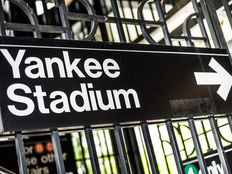
The New York Yankees may be well known for their monster $220 million annual payroll – second only to the LA Dodgers’ $273 million – but they’re a bit more frugal when it comes to paying interest on their debt. In August, the baseball team unveiled plans to refinance nearly $1 billion worth of bonds issued to build the team’s new stadium and save $10 million in interest, but investors may want to think twice before buying into these stadium bonds.
In this article, we’ll take a closer look at the bond issue, and whether sports fans should consider an investment.
A New Stadium
The new Yankees stadium was built (and opened) in April 2009 to resemble the original 1923 stadium before its renovations in the 1970s. In total, the stadium cost $2.3 billion to build, including $1.2 billion worth of public subsidies, making it the most expensive stadium ever built. While the stadium’s amenities are certainly impressive, many people have criticized the high ticket prices that came with it, despite the significant public subsidies it received.
The team originally issued tax-exempt municipal bonds in 2006 and 2009 to build the new stadium. These bonds are backed by New York’s Industrial Development Agency, which owns the stadium and leases it to the team. While the baseball team ranks 15th in attendance, it draws nearly 40,000 fans per game and has withstood the economy’s ups and downs. This prompted Moody’s to upgrade its ratings to Baa2 from Baa3 – the lowest investment grade.
In addition to the stadium, Bronx Parking Development Co. operates garages and several parking lots near the stadium, which it issued its own muni bonds to finance. These bonds ran into trouble in 2013 when it defaulted on some $237 million worth of publicly subsidized bonds. While the parking operations generated $11 million in revenue in 2014, it had operating expenses of $6 million and fell short of the $34 million owed to bondholders and the city.
Shaky Track Record
Municipal bond investors may want to steer clear of stadium bonds based on their shaky track record over the years. Since they’re dependent on revenue from sporting events, these bonds have a credit profile that fluctuates to a large extent based on team performance and occupancy rates. Many of these stadiums either suffer from periodic slowdowns at best or are shut down as teams move to new cities at the worst.
For example, New Jersey residents were on the hook for some $110 million in debt back in 2010 for the old Giants stadium that was demolished in order to build the New Meadowlands Stadium (now the MetLife Stadium). The lack of a sports team significantly reduced the project’s ability to repay bondholders and thus investors suffered. Similar stories of abandoned stadiums with large debts left in the aftermath can be found in cities like Houston, Kansas City, Memphis and Pittsburgh, among others.
The New York Yankees stadium may be different due to the franchise’s long-standing popularity, but that doesn’t mean investors don’t face any risk. Fitch’s ratings upgrade still places these muni bonds just two notches above investment grade, and well below many other muni bond offerings. Investors may be rewarded with higher yields, but whether it’s worth it depends largely on their risk tolerance.
The Bottom Line
The New York Yankees are planning on refinancing around $1 billion worth of municipal bonds used to finance a new stadium. While Yankees fans may be tempted by the bonds and their high yields, history suggests that investors should exercise caution when buying stadium bonds. The good news is that the Yankees have demonstrated a more robust fan base than many other teams, which encouraged Fitch to upgrade its rating on the bonds to Baa2.






